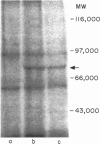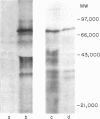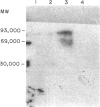Abstract
Human blood polymorphonuclear (PMN) leucocytes and human leucocytes of the HL-60 line, which were induced to differentiate by 1,25-dihydroxyvitamin D3, express stereospecific receptors for the potent chemotactic mediator, leukotriene B4 (LTB4), that is derived by 5-lipoxygenation from arachidonic acid. Monoclonal antibodies to LTB4 receptors (LTB4-R) were generated by immunizing BALB/c mice with partially purified PMN leucocyte membrane proteins, and fusing their splenocytes with P3X63Ag8 mouse myeloma cells. Hybridoma supernatants were screened initially by binding to PMN leucocyte LTB4-R protein, which had been affinity cross-linked with aminopropylamide (APA)-LTB4 and immobilized in plastic wells through attachment of the linked APA-LTB4 to adherent Fab of monoclonal anti-LTB4. Of the three clones producing antibodies which bound to LTB4-R, 0.5 mg/ml of one IgG3k antibody, termed E2, precipitated over 90% of the [3H]LTB4-binding activity of solubilized PMN leucocyte membrane proteins. E2 also bound to a radiolabelled protein of 70,000-80,000 MW from 125I-labelled PMN leucocyte membranes [35S]-labelled HL-60 cell membranes, and PMN leucocyte membranes affinity-labelled with [3H]APA-LTB4, that was identical in size to the LTB4-R precipitated by the rabbit IgG anti-idiotypic antibodies. E2 did not bind to intact PMN leucocytes or modify the binding of [3H]LTB4 by PMN leucocytes. The binding of E2 to LTB4-R in purified membranes of PMN leucocytes was less than one-fourth of that observed for the anti-idiotypic antibodies, but increased substantially after solubilization of the LTB4-R. The E2 monoclonal antibody thus recognizes a partially latent substituent of LTB4-R, which does not contribute to combining site function.
Full text
PDF






Images in this article
Selected References
These references are in PubMed. This may not be the complete list of references from this article.
- De Lean A., Hancock A. A., Lefkowitz R. J. Validation and statistical analysis of a computer modeling method for quantitative analysis of radioligand binding data for mixtures of pharmacological receptor subtypes. Mol Pharmacol. 1982 Jan;21(1):5–16. [PubMed] [Google Scholar]
- Gifford L. A., Chernov-Rogan T., Harvey J. P., Koo C. H., Goldman D. W., Goetzl E. J. Recognition of human polymorphonuclear leukocyte receptors for leukotriene B4 by rabbit anti-idiotypic antibodies to a mouse monoclonal antileukotriene B4. J Immunol. 1987 Feb 15;138(4):1184–1189. [PubMed] [Google Scholar]
- Goldman D. W., Gifford L. A., Young R. N., Marotti T., Cheung M. K., Goetzl E. J. Affinity labeling of the membrane protein-binding component of human polymorphonuclear leukocyte receptors for leukotriene B4. J Immunol. 1991 Apr 15;146(8):2671–2677. [PubMed] [Google Scholar]
- Goldman D. W., Goetzl E. J. Heterogeneity of human polymorphonuclear leukocyte receptors for leukotriene B4. Identification of a subset of high affinity receptors that transduce the chemotactic response. J Exp Med. 1984 Apr 1;159(4):1027–1041. doi: 10.1084/jem.159.4.1027. [DOI] [PMC free article] [PubMed] [Google Scholar]
- Goldman D. W., Olson D. M., Payan D. G., Gifford L. A., Goetzl E. J. Development of receptors for leukotriene B4 on HL-60 cells induced to differentiate by 1 alpha,25-dihydroxyvitamin D3. J Immunol. 1986 Jun 15;136(12):4631–4636. [PubMed] [Google Scholar]
- Immunochemical techniques. Part B. Methods Enzymol. 1981;73(Pt B):1–739. [PubMed] [Google Scholar]
- Klempner M. S., Mikkelsen R. B., Corfman D. H., André-Schwartz J. Neutrophil plasma membranes. I. High-yield purification of human neutrophil plasma membrane vesicles by nitrogen cavitation and differential centrifugation. J Cell Biol. 1980 Jul;86(1):21–28. doi: 10.1083/jcb.86.1.21. [DOI] [PMC free article] [PubMed] [Google Scholar]
- Lee J. Y., Chernov T., Goetzl E. J. Characteristics of the epitope of leukotriene B4 recognized by a highly specific mouse monoclonal antibody. Biochem Biophys Res Commun. 1984 Sep 28;123(3):944–950. doi: 10.1016/s0006-291x(84)80225-9. [DOI] [PubMed] [Google Scholar]
- Markwell M. A. A new solid-state reagent to iodinate proteins. I. Conditions for the efficient labeling of antiserum. Anal Biochem. 1982 Sep 15;125(2):427–432. doi: 10.1016/0003-2697(82)90025-2. [DOI] [PubMed] [Google Scholar]
- Munson P. J., Rodbard D. Ligand: a versatile computerized approach for characterization of ligand-binding systems. Anal Biochem. 1980 Sep 1;107(1):220–239. doi: 10.1016/0003-2697(80)90515-1. [DOI] [PubMed] [Google Scholar]
- Organist M. L., Harvey J., McGillis J. P., Mitsuhashi M., Melera P., Payan D. G. Characterization of a monoclonal antibody against the lymphoblast substance P receptor. J Immunol. 1987 Nov 1;139(9):3050–3054. [PubMed] [Google Scholar]
- Rokach J., Hayes E. C., Girard Y., Lombardo D. L., Maycock A. L., Rosenthal A. S., Young R. N., Zamboni R., Zweerink H. J. The development of sensitive and specific radioimmunoassays for leukotrienes. Prostaglandins Leukot Med. 1984 Jan;13(1):21–25. doi: 10.1016/0262-1746(84)90098-2. [DOI] [PubMed] [Google Scholar]
- Young R. N., Zamboni R., Rokach J. Studies on the conjugation of leukotriene B4 with proteins for development of a radioimmunoassay for leukotriene B4. Prostaglandins. 1983 Oct;26(4):605–613. doi: 10.1016/0090-6980(83)90197-1. [DOI] [PubMed] [Google Scholar]





